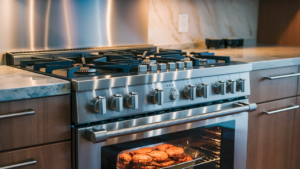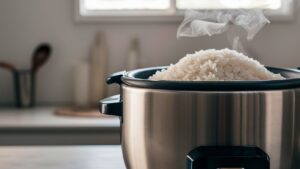Ceramic knives are sharper and retain their edge longer than steel knives. However, steel knives offer better durability and versatility for heavy-duty tasks.
Choosing between ceramic and steel knives involves understanding their unique benefits and limitations. Ceramic knives shine in precision tasks, such as slicing vegetables and fruits, thanks to their sharpness and lightweight design. They resist rust and do not react with acidic foods, preserving the freshness of ingredients.
On the other hand, steel knives are robust and versatile, excelling in various kitchen tasks, including chopping and slicing tougher ingredients. While ceramic knives maintain their sharpness longer, they are more fragile and challenging to sharpen. Both knife types have their ideal applications, making them valuable tools in any kitchen.

Ceramic Knife Vs Steel Knife: The Essentials
Ceramic knives are made from a hard material called zirconia. This makes them very sharp and lightweight. They do not rust, which helps keep them looking new.
Steel knives are made from iron mixed with carbon. This gives them strength and flexibility. They are great for heavy-duty tasks.
In terms of edge retention, ceramic knives stay sharp for a long time. They require less frequent sharpening. Steel knives, while easier to sharpen, can dull faster.
Both types have their pros and cons. Ceramic knives excel in fine slicing and decorative cutting. Steel knives are better for tougher tasks.
The Sharpness Showdown
Ceramic knives excel in their initial cutting ability. They are often sharper than steel knives. This sharpness allows for precise slicing, making them great for fruits and vegetables. Their hardness contributes to this superior sharpness.
In terms of longevity, ceramic knives maintain their edge longer than steel. They resist dulling from normal use, making them ideal for regular kitchen tasks. On the other hand, steel knives may require frequent sharpening.
Despite their advantages, ceramic knives can be fragile. They may chip or break if dropped. Steel knives offer more flexibility and are better suited for heavy-duty tasks. This makes them a versatile choice for various kitchen needs.
Weight And Handling
Weight plays a significant role in knife handling. Ceramic knives are typically lighter than steel knives. This makes them easier to use for extended periods. The reduced weight can help prevent hand fatigue.
Control is crucial for precise cutting. Ceramic knives offer a sharp edge that aids in fine slicing. They allow for better maneuverability, especially with delicate foods. Steel knives provide more weight, which can enhance stability for heavier tasks.
Precision also varies between the two types. Ceramic knives excel at decorative cutting due to their sharpness. Steel knives are better suited for heavy-duty tasks where force is needed.
Durability Dynamics
Ceramic knives are known for their excellent resistance to wear. They remain sharp much longer than steel knives. This feature makes them ideal for precision tasks.
On the other hand, steel knives offer more flexibility and toughness. They are less prone to chipping compared to their ceramic counterparts. Steel can handle heavy-duty tasks better than ceramic knives.
In terms of chipping susceptibility, ceramic knives are more fragile. A small drop can lead to chips or breaks. Steel knives are more robust, making them suitable for various cutting jobs.
| Knife Type | Resistance to Wear | Susceptibility to Chipping |
|---|---|---|
| Ceramic Knife | Excellent | High |
| Steel Knife | Good | Low |
Maintenance And Care
Ceramic knives are known for their ability to retain sharpness longer than steel knives, making them ideal for precision tasks. While they offer a lightweight option, they can be more fragile and challenging to sharpen. Steel knives, on the other hand, provide durability and versatility for various kitchen tasks.
Sharpening Techniques
Ceramic knives are tougher to sharpen than steel knives. Use a diamond sharpener for best results. Steel knives can be sharpened with various tools. Honing rods work well for steel blades. Regularly sharpen steel knives to maintain their edge.
Care Practices
Keep ceramic knives away from hard surfaces. They can easily chip or break. Store them in a knife block or sheath. Steel knives require less delicate handling. Avoid soaking them in water for long periods.
Clean ceramic knives with a soft sponge. Steel knives can be washed in a dishwasher. Always dry both types immediately after washing.
Versatility In The Kitchen
Ceramic knives excel at tasks like fine slicing and decorative cutting. They remain sharper for longer periods, making them ideal for fruits and vegetables. Their lightweight design allows for easy handling.
Steel knives are better for heavy-duty tasks. They provide the strength needed for cutting through tougher materials. Steel is also more flexible, which helps in various cutting techniques. For general kitchen tasks, steel knives are highly versatile.
| Knife Type | Suitable Tasks | Limitations |
|---|---|---|
| Ceramic | Fine slicing, decorative cutting | Brittle, difficult to sharpen |
| Steel | Heavy-duty cutting, versatile tasks | Requires regular sharpening |
Cost Considerations
Price range for ceramic knives is often lower than that of steel knives. Basic ceramic knives can start around $20. High-quality ceramic options may reach up to $50. In contrast, steel knives vary widely in price. You can find decent steel knives for $30 to $100. Premium models can cost $200 or more.
Value for money is an important factor. Ceramic knives offer excellent performance for slicing fruits and vegetables. They stay sharp longer, reducing the need for frequent replacements. Steel knives, however, provide versatility for various kitchen tasks. Their durability makes them a wise investment for heavy-duty use.
| Knife Type | Price Range | Value for Money |
|---|---|---|
| Ceramic | $20 – $50 | Great for slicing, stays sharp longer |
| Steel | $30 – $200+ | Versatile, durable for heavy use |
Pros And Cons At A Glance
Ceramic knives offer superior sharpness and longevity, making them ideal for precise cutting tasks. Conversely, steel knives provide durability and flexibility, suited for heavy-duty kitchen tasks. Weighing the pros and cons helps determine which knife fits your culinary needs best.
Benefits Of Ceramic Knives
Ceramic knives are known for their ability to stay sharp longer than steel. This means less frequent sharpening, saving time and effort. They are also lighter, making them easy to handle. Their hardness allows for sharper edges, ideal for precise cutting. Ceramic knives do not rust, ensuring they stay clean and fresh. They help in preserving food quality by preventing browning.
Advantages Of Steel Knives
Steel knives offer more flexibility and durability. They are less likely to chip or break, making them suitable for heavy-duty tasks. Steel blades are easier to sharpen, giving quick access to a sharp edge. They can handle a variety of cooking tasks, from slicing to chopping. Overall, steel knives provide more versatility in the kitchen.
Making The Right Choice
Choosing between a ceramic knife and a steel knife depends on personal preferences. Ceramic knives are lightweight and stay sharper longer. They are great for fine slicing and do not rust. On the other hand, steel knives offer flexibility and are better for heavy-duty tasks.
In terms of culinary requirements, consider what you cook most often. If you enjoy fruits and vegetables, a ceramic knife might be ideal. If you often work with meat or harder foods, a steel knife will perform better. Each type has its pros and cons to weigh.
Ultimately, the best choice is one that fits your kitchen style and cooking habits. Think about how often you cook and the types of foods you prepare.
Expert Opinions And Tests
Culinary professionals have varied opinions on ceramic and steel knives. Many chefs appreciate the sharpness and lightweight nature of ceramic knives. They tend to stay sharp longer, making them ideal for fine slicing and decorative tasks.
On the other hand, steel knives offer more versatility and flexibility. They handle heavy-duty tasks better than their ceramic counterparts. Steel blades are easier to sharpen and maintain, which is crucial in a busy kitchen.
Fragility is a significant drawback of ceramic knives. They can easily chip or break under pressure. Chefs often prefer steel for tasks requiring more strength and control.
| Feature | Ceramic Knives | Steel Knives |
|---|---|---|
| Sharpness | Stays sharper longer | Can dull faster |
| Weight | Lightweight | Heavier |
| Durability | Fragile | Durable |
| Maintenance | Hard to sharpen | Easy to sharpen |
Frequently Asked Questions
Is A Ceramic Knife Better Than Steel?
Ceramic knives excel in sharpness and longevity compared to steel knives. They remain sharper longer and are lighter. However, they are more fragile and harder to sharpen. For heavy-duty tasks, steel knives are often a better choice. Each type has its own advantages depending on the use case.
What Are The Disadvantages Of Ceramic Knives?
Ceramic knives have several disadvantages. They are brittle and can chip easily. These knives lack flexibility, making them less versatile. Sharpening them is challenging and often requires special tools. They are not suitable for heavy-duty tasks, limiting their use in a busy kitchen.
Are Ceramic Or Steel Blades Better?
Ceramic blades are sharper and lighter, staying sharp longer than steel. They excel in fine slicing but can chip easily. Steel blades are more durable and versatile for heavy-duty tasks. Choose based on your specific kitchen needs.
What Are The Benefits Of Using A Ceramic Knife?
Ceramic knives offer several benefits. They stay sharper longer than steel knives, making them ideal for precise cutting. They resist rust and do not cause food to brown. Lightweight and easy to handle, ceramic knives excel in slicing fruits and vegetables without bruising.
Conclusion
Choosing between a ceramic knife and a steel knife depends on your cooking style. Ceramic knives excel in sharpness and longevity, making them ideal for precise cutting. Steel knives, however, offer durability and versatility for heavy-duty tasks. Assess your needs carefully to find the right fit for your kitchen.








